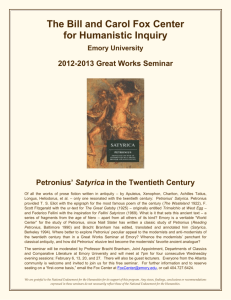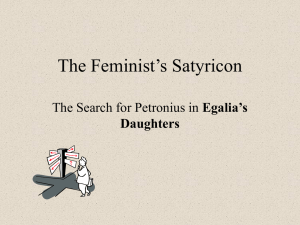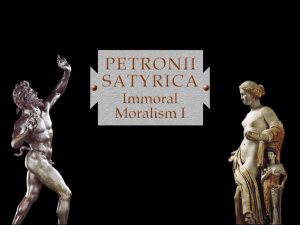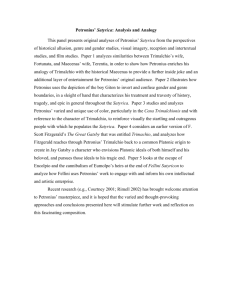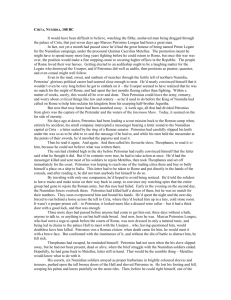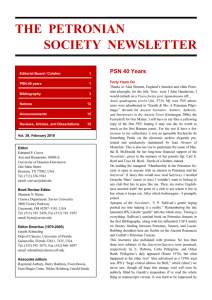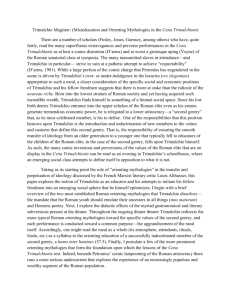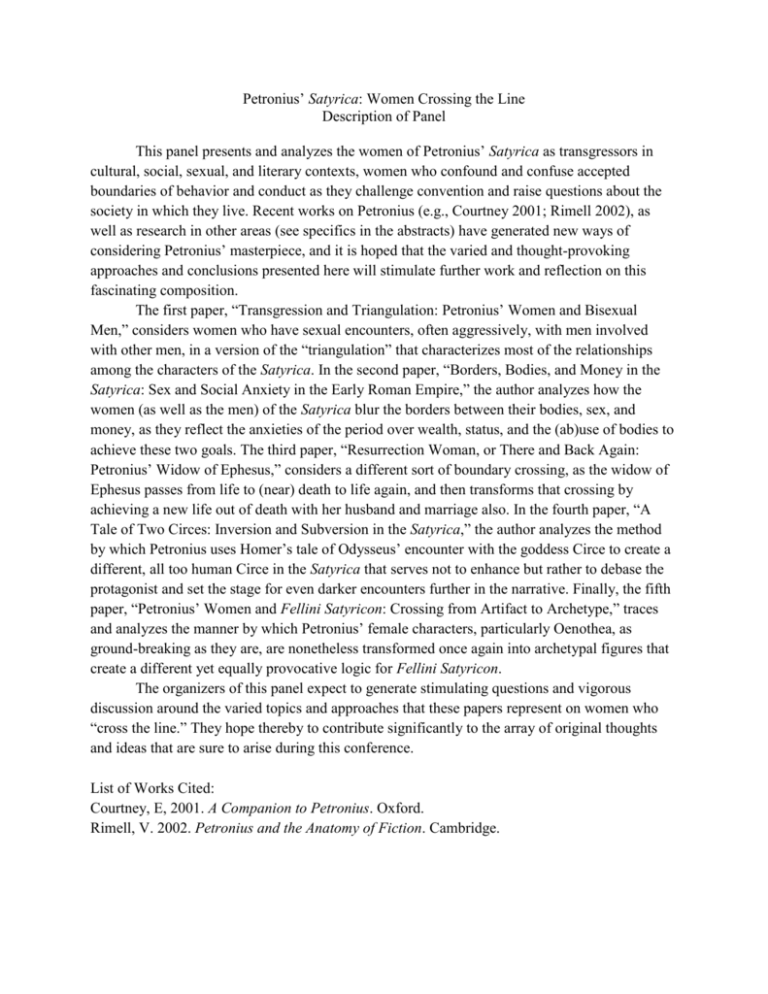
Petronius’ Satyrica: Women Crossing the Line
Description of Panel
This panel presents and analyzes the women of Petronius’ Satyrica as transgressors in
cultural, social, sexual, and literary contexts, women who confound and confuse accepted
boundaries of behavior and conduct as they challenge convention and raise questions about the
society in which they live. Recent works on Petronius (e.g., Courtney 2001; Rimell 2002), as
well as research in other areas (see specifics in the abstracts) have generated new ways of
considering Petronius’ masterpiece, and it is hoped that the varied and thought-provoking
approaches and conclusions presented here will stimulate further work and reflection on this
fascinating composition.
The first paper, “Transgression and Triangulation: Petronius’ Women and Bisexual
Men,” considers women who have sexual encounters, often aggressively, with men involved
with other men, in a version of the “triangulation” that characterizes most of the relationships
among the characters of the Satyrica. In the second paper, “Borders, Bodies, and Money in the
Satyrica: Sex and Social Anxiety in the Early Roman Empire,” the author analyzes how the
women (as well as the men) of the Satyrica blur the borders between their bodies, sex, and
money, as they reflect the anxieties of the period over wealth, status, and the (ab)use of bodies to
achieve these two goals. The third paper, “Resurrection Woman, or There and Back Again:
Petronius’ Widow of Ephesus,” considers a different sort of boundary crossing, as the widow of
Ephesus passes from life to (near) death to life again, and then transforms that crossing by
achieving a new life out of death with her husband and marriage also. In the fourth paper, “A
Tale of Two Circes: Inversion and Subversion in the Satyrica,” the author analyzes the method
by which Petronius uses Homer’s tale of Odysseus’ encounter with the goddess Circe to create a
different, all too human Circe in the Satyrica that serves not to enhance but rather to debase the
protagonist and set the stage for even darker encounters further in the narrative. Finally, the fifth
paper, “Petronius’ Women and Fellini Satyricon: Crossing from Artifact to Archetype,” traces
and analyzes the manner by which Petronius’ female characters, particularly Oenothea, as
ground-breaking as they are, are nonetheless transformed once again into archetypal figures that
create a different yet equally provocative logic for Fellini Satyricon.
The organizers of this panel expect to generate stimulating questions and vigorous
discussion around the varied topics and approaches that these papers represent on women who
“cross the line.” They hope thereby to contribute significantly to the array of original thoughts
and ideas that are sure to arise during this conference.
List of Works Cited:
Courtney, E, 2001. A Companion to Petronius. Oxford.
Rimell, V. 2002. Petronius and the Anatomy of Fiction. Cambridge.
Transgression and Triangulation: Petronius’ Women and Bisexual Men
In contrast to the Greek novel where sexual symmetry marks the relationship of the
lovers Satyrica, as noted by E. Courtney (2001), features the “triangulation” of sexual
relationships. Thus, whether the relationships are heterosexual (e.g. Widow of Ephesus-husband--soldier) or homosexual (Encolpius-Giton-Ascyltus), the presence of the third party
often drives the dynamic of the erotic escapades. Adding a further level of complication to these
triangles is male bisexuality because several of the female characters engage with a male
involved in a same-sex relationship. Among these women are Fortunata, Scintilla, Quartilla,
Tryphaena, Chrysis, and Circe. In a novel where the breakdown of sexual boundaries is so
prominent (“gender dissonance,” to use M. Skinner’s term [Skinner. 2005]) the interaction of the
heterosexual female with the bisexual male provides rich material for a discussion of
male/female roles.
Among married women we see Fortunata and Scintilla for whom their husbands’
catamites are a source of wifely resentment. For other women, the homosexual component of the
male is simply a given, and, interestingly, is no barrier to female aggressiveness toward the male.
So Quartilla, whose own house is filled with eunuchs and cinaedi, displays attraction to
Encolpius’ Giton but soon arranges for him to deflower Pannychis. Tryphaena also displays
attraction to Giton, who is ever the androgyne and often assumes the role of the tragic and epic
heroine. Despite their awareness of Encolpius’ obsession with his deliciae, both Circe and
Chrysis demonstrate their attraction to him. Most remarkable, however, amid the many scenes of
gender transgression and female aggression is the degradation of Encolpius’ manhood when he is
penetrated at the hands of a woman (Oenothea). In sum, the theme of females who want males
who want males represents a uniquely original treatment of gender on the part of Petronius.
List of Works Cited:
Courtney, E, 2001. A Companion to Petronius. Oxford.
Skinner, M. 2005. Sexuality in Greek and Roman Culture. Blackwell.
Borders, Bodies, and Money in the Satyrica:
Sex and Social Anxiety in the Early Roman Empire
In a seminal article, Fergus Millar (1981) situates the social and historical insights in
Apuleius’ Golden Ass in the “solidly realistic background” that provides the setting for the
“fantastic goings-on” of the novel. The social world of the Satyrica has no less vivid a backdrop,
and it is possible to discern the “real” Roman world in the chaotic, erotic, and sometimes
disturbing environment through which the text’s narrator, Encolpius, travels.
Two episodes in the surviving fragments of the Satyrica explore the relationship between
sex, money, and anxiety. Encolpius encounters Fortunata, who provides a feminine counterpart
to her husband Trimalchio: similarly garish, she had been a prostitute (Sat. 77) and is now
obsessively consumed with her newfound wealth (Sat. 67). Later, Encolpius and Eumolpus meet
an aging legacy hunter named Philomela, who shamelessly prostitutes her children to Eumolpus
in the fervent hope of obtaining his (non-existent) fortune (Sat. 140). Strikingly, the appearances
of both Fortunata and Philomela lead other characters to focus on their wealth: Trimalchio
reminisces yet again to an audience already familiar with the story about the inheritance that
made him wealthy (Sat 76), while Eumolpus turns his attention to composing his very strange
will (Sat. 141).
In a text consumed with decadence and self-interest, these episodes sexualize the transfer
of wealth. In a conflation and confusion of sex and money, while Fortunata’s body is eroticized,
her marriage is a financial arrangement, as is evident by Trimalchio’s display of his wife’s
jewelry (Sat. 67). Eumolpus’ will, which specifies that his heirs will be compelled to consume
his flesh, illustrates the boundary dissolution among seduction, corporeality, and financial gain.
This presentation of sexual relationships and their opportunistic financial dimensions resonates
with the anxieties about the security of personal wealth which characterize this and other
literature of this period (Damon. 1998).
List of Works Cited:
Damon, C. 1998. The Mask of the Parasite: A Pathology of Roman Patronage. Ann Arbor.
Millar, F. 1981. “The World of The Golden Ass.” JRS 71. 63-75
Resurrection Woman, or There and Back Again: Petronius's Widow of Ephesus
The central figure in the inset Milesian tale of the Widow of Ephesus (Satyrica 111-112),
told by the poet Eumolpus to calm feelings and restore harmony on Lichas's ship, crosses a
dizzying variety of boundaries (Conte. 1006; Slater. 1990). While the primary boundary she
transgresses is that between life and death, she leads the way across many other categorical
divides as well on her way to claiming speech, agency, and power over death by the narrative's
end. This matron first appears as a spectacle of chastity so powerful that she draws women from
other countries to gaze on her. She follows her deceased husband into the tomb, apparently
planning to starve herself over his body. A single sentence then juxtaposes the mourning widow
underground and the crucified bodies of criminals above, guarded by a soldier. Drawn by lights
and groans, he crosses into the tomb and finds her. First persuading her maid back to life with
food and drink, the soldier then joins her in winning over the widow also: no longer the bride of
death, she celebrates a new wedding (nuptias) with the soldier behind the only now closed doors
of the tomb. With the soldier below ground, the family of one crucified criminal seizes the
chance to reclaim his body from the cross. Discovering his dereliction, the soldier plans suicide.
For the first time in the narrative, the widow moves from virtuous silence to recorded speech: in
a superb reversal of Stoic couple suicides, the widow invokes the gods to forbid such an end and
arranges for her late husband's body to replace the missing one on the cross. The story ends with
the populace that once admired the widow's chastity marveling at the new body on the cross. The
internal audience's complicity endorses the widow's power to transcend boundaries.
List of Works Cited:
Conte, G.B. 1996. The Hidden Author: An Interpretation of Petronius' Satyricon.
Berkeley.
Slater, N. 1990. Reading Petronius. Baltimore, MD and London.
A Tale of Two Circes: Inversion and Subversion in the Satyrica
The Satyrica is, among other things, an anti-epic, with anti-heroes and other characters that not
only cross the line between epic and its other, but also transgress many other literary and social
conventions, mores, and boundaries (Rimell. 2002; Courtney. 2001; Connors. 1998; Slater.
1990). This paper analyzes how Petronius inverts and subverts the character of Circe in Homer’s
Odyssey; as the only character whose name Petronius takes directly from Homer’s epic, he
portrays his Circe as the opposite of her model in the Odyssey, just as Encolpius is the anti-hero
to the Odyssey’s hero. Homer’s Circe (Odys. 10.212-541) is a goddess versed in magic, “the
loveliest of all immortals” to Odysseus who, after releasing his men from her spell, remains with
her for a year, his virility protected from her magic by Hermes. By contrast, Petronius’ Circe,
like her namesake, “lovelier than any work of art,” is nonetheless an all too mortal woman
attracted not to heroes but rather to “the lowest of the low” in Encolpius’ disguise as a slave
(Satyr. 126). The episode in the Satyrica inverts the significance of the Homeric interlude, as
Encolpius, unable to achieve an erection, cries out that he has been “bewitched,” rather than
protected by, the gods. This encounter then becomes a prelude to even greater humiliation for
Encolpius at the hands of Proselenus and Oenothea. Petronius thus employs his Circe not to
elevate and enhance his protagonist, as Homer does, but rather to subversively amplify the
opposite qualities in both Encolpius and the Satyrica in general. Just as his Circe abandons her
epic namesake and irretrievably crosses a line into behavior unacceptable to a woman of her
status (let alone a goddess), so, Petronius seems to be suggesting, has Rome in general under
Nero become an inverted imitation of its former, nobler self.
List of Works Cited:
Connors, C. 1998. Petronius the Poet: Verse and Literary Tradition in the Satyrison.
Cambridge.
Courtney, E, 2001. A Companion to Petronius. Oxford.
Rimell, V. 2002. Petronius and the Anatomy of Fiction. Cambridge.
Slater, N. 1990. Reading Petronius. Baltimore, MD and London.
Petronius' Women and Fellini Satyricon: Crossing from Artifact to Archetype
One of the more extraordinary encounters with Petronius’ Satyrica and 20th century
culture is Federico Fellini’s film, Fellini Satyricon (1969). Neither a staging nor an illustration of
the ancient text, the film is a powerful vision of antiquity seen as, effectively, an alien planet—or
rather, the dream of an alien planet. The film tears apart conventional visual styles that had
created a popular niche for ―sword and sandal‖ films, and sought to avoid or explode the
various clichés that had made the ancient world stale and all-too-familiar in the cinema,
particularly in the era of Italian fascism.
The film was a liberating breakthrough for Fellini, who had been at an impasse in his
career. One element in his creative liberation was his recourse to analytic psychology, upon
which he had already relied while making 8 1/2. His interest in archetypal images, I argue,
helped him to shape the ending of the film, which, in spite of the disjointed nature of much of it,
does have a definite narrative structure towards the end. After various adventures, the young
Encolpio suffers a crisis of impotence, which ultimately must be cured by Enotea, a figure that
fluctuates between haughty beauty and Earth Mother. Cured and newly remade after his ritual
intercourse with Enotea, Encolpio seems ready to be freed for further adventures, when the
film’s narrative tapers off.
This paper traces the evolution of Fellini’s deployment of ritualized and archetypical
views of the feminine. Beginning with the Petronian fragments concerning Oenothea which
inspired his plot, I trace the congeries of texts and themes that led to the final version of Fellini
Satyricon.

